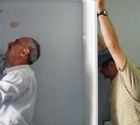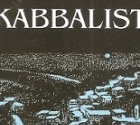
The book cover
With so many these days lamenting the demise of kibbutzim, it is heartening to find a book that puts the emphasis on the first hundred years of the kibbutz movement.
As a kibbutz member for over 40 years, I hope this signals that there will still be kibbutzim and other cooperative communities also in the far-off future.
Jointly published by Yad Ya'ari, Yad Yitzhak Tabenkin and Yad Yitzhak Ben Zvi, the almost 400 page book edited by Professor Aviva Halamish and Dr. Zvi Tzemeret, contains a wealth of photographs, posters, cartoons and graphics that would also appeal to non-Hebrew readers with a warm place in their hearts for Zionism and for the pioneers and development of the kibbutzim.
The hard cover of the publication is intriguing as one gets drawn to three kibbutzniks, their backs to the camera, sketching a cow laying in muck in a kibbutz dairy. A tall grain silo, stacks of hay and a long storage shed are in the background. The kibbutz artists in their thirties, one wearing a shirt, the second a sweater and the third very gentlemanly in a cloth jacket, noch! Two of the sketchers are sitting on wooden boxes and the third on a pile of undergrowth.
One would expect such a book cover to feature pioneers filling the soil and draining the swamps of the Promised Land, or at least picking fruit or milking the cow – not drawing the animal resting on her laurels and udder in a pile of muck. The photograph was taken in 1952 on Kibbutz Na'an.
"I wanted to show that the people of the kibbutzim were always recording, and continue to do so these days, in art, writing, song and poetry the unique way of life they participated in creating," explains Yuval Danieli who traveled the length and breadth of Israel searching kibbutz archives for the photographic and graphic material for the book.
Each of the artists in Na'an signify individually how they see kibbutz. Their drawings and paintings will not be the same, purely an individual narrative of what the kibbutz meant and looked like to them," says Danieli, a copy of the book open on page 127 which shows a young woman, a sack full of seeds tied to her waste, sowing in a field, wooden huts in the background and Mt. Tabor across the Jezreel Valley.
I take a few seconds to realize that I am looking at a photograph taken in my own kibbutz many years before I joined in the 1960s.
"For me 'The Kibbutz: the First 100 Years' has been a labor of love. I wanted to bring to the forefront the effect of the photographers and artists in helping to record and maintain the very special character of the kibbutz movement – to strengthen the rich text and to salute the men and women who also took up pencil, pen, box of paints and sculpting tools to enrich the history of the movement whilst they themselves were also creating it," said Danieli.
Yuval Danieli, a member of Kibbutz HaMa'apil is an accomplished artist and art historian of the kibbutz movement. He worked with fellow historian Muki Tzur from Ein Gev on the 100th anniversary publication. "In the last 10 years Muki and I have worked together on five albums focusing on culture of the kibbutzim and collectives in Israel. Apart from the Rosh Hashanah greeting cards and Haggadot by kibbutz artists, and architecture, we also dealt with industry and education," said Danieli, the Director of the Kibbutz Movement Art Archives, Artists and Exhibitions.
Sitting in his book-lined and spacious office at Givat Haviva, Danieli pulls out a beige folder crammed with original material used for one of those publications. There are dozens of such folders, and hundreds of books and posters stacked on the shelves and in a very large antique and rarely seen dark wood, glass-windowed dining room cupboard, all on hand in his office.
"We are researching and documenting the creators and their creations from the present and past generations who have been creating over the last 100 years, and through the images of so many talented artists we continue the narrative of the past, present and hopefully, the future."
The "Kibbutz First 100 Years" book is available from Yad Yaari Archives (Givat Haviva) at yariarch@givathaviva.org.il or call 04 630 9232 (Sunday through Wednesday).
 A PLACE OF THEIR OWN
A PLACE OF THEIR OWN THANK YOU!
THANK YOU! DEAR EDITOR 156
DEAR EDITOR 156 Robert Kwong at the Yeshiva
Robert Kwong at the Yeshiva  Friday Night with the Pope - A Book Review
Friday Night with the Pope - A Book Review The Kabbalist - A Book Review
The Kabbalist - A Book Review  Lydia Aisenberg
Lydia Aisenberg